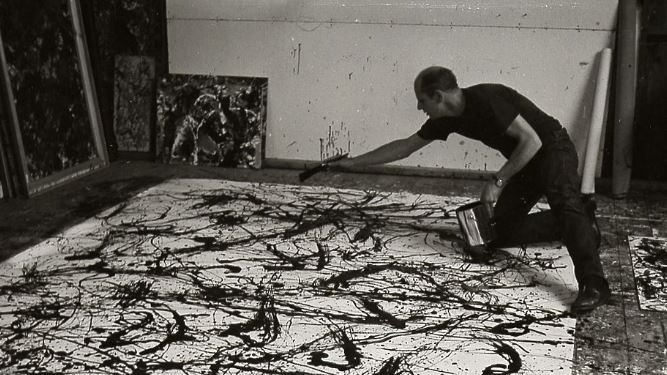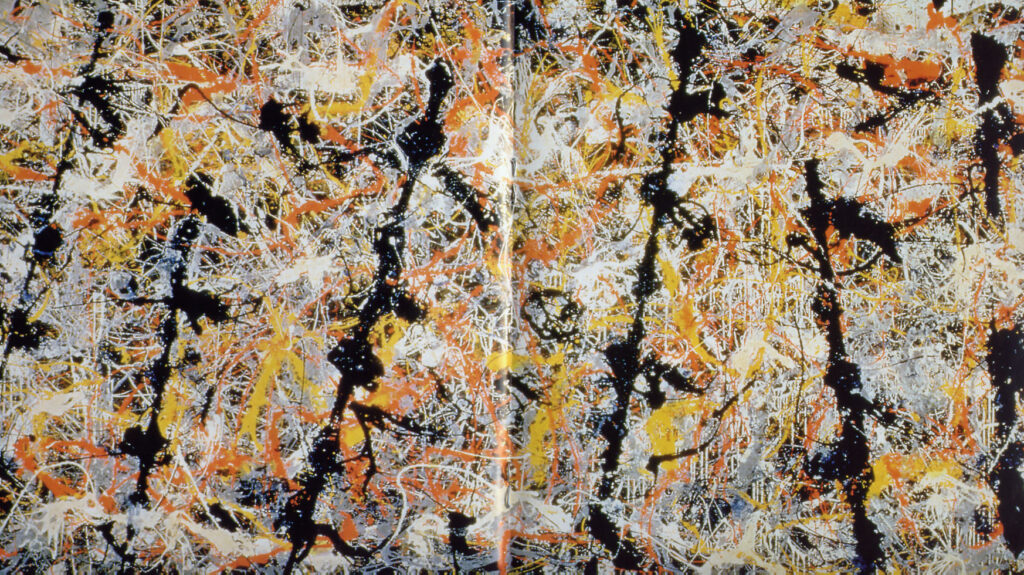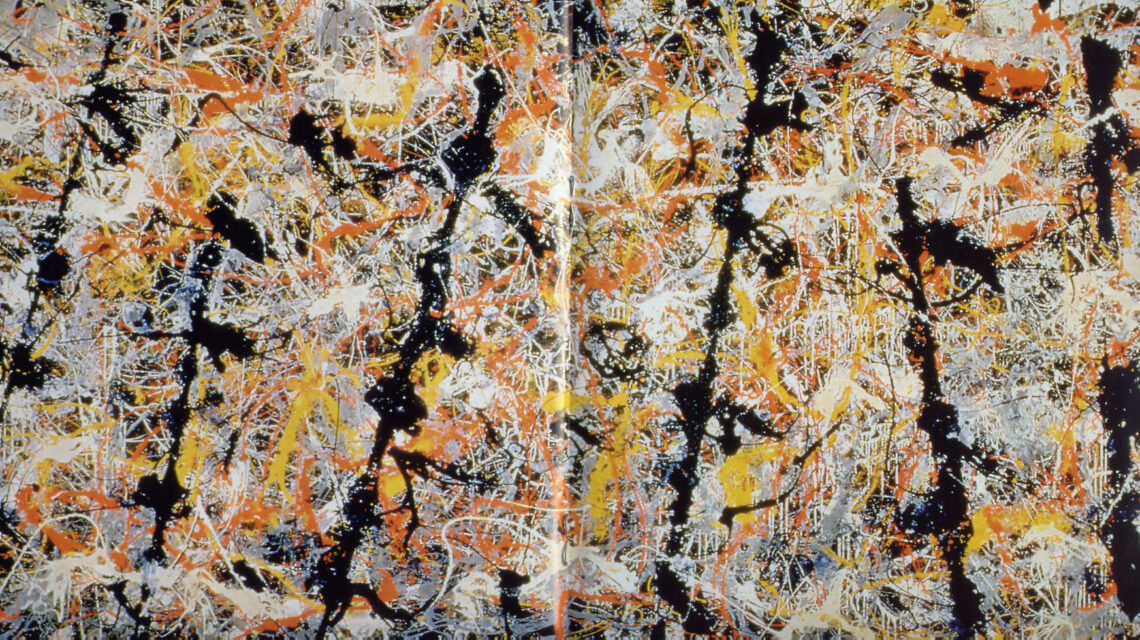Alright, buckle up, because we’re about to take a deep dive into the mesmerizing world of abstract expressionism, led by none other than the legendary Jackson Pollock. Our main focus? One of his absolute stunners – “Blue Poles.” In this article, we’ll stroll through Pollock’s life, peek into the behind-the-scenes of his artistic career, dissect the vibrant chaos of “Blue Poles,” and sprinkle in some juicy tidbits about this iconic piece.
Who was Jackson Pollock?

First things first – Jackson Pollock was the cool cat of the art scene in the early to mid-20th century. Born in Wyoming in the year 1912, he wasn’t your average painter. No, siree. Pollock was the rebel of the canvas, tossing tradition out the window to embrace a revolutionary form of expression. His claim to fame? Dripping and pouring colour onto canvases spread out on the floor, a technique that would make him the rockstar of abstract expressionism and earn him the nickname “Jack the Dripper.”
His Career

Picture this: World War II was raging on, and amid the chaos, Pollock was quietly stirring up a different kind of storm in the art world. The 1940s marked the rise of his unconventional yet captivating drip paintings. These weren’t your typical landscapes or portraits. Nope, they were explosive bursts of color and energy that shook up the artistic landscape.
As the art world grappled with the aftermath of the war, Pollock became a pivotal figure in the abstract expressionist movement. His unique approach to painting – an intricate dance of dripping and pouring – set the stage for a prime era in art. Critics and admirers alike were forced to take notice of this great artist who dared to challenge the status quo.
What is happening in Blue Poles?

| Artist | Jackson Pollock |
| Date Painted | 1952 |
| Medium | Oil and enamel on canvas |
| Genre | Abstract Expressionism |
| Period | Post-WWII |
| Dimensions | 7 feet x 11 feet |
| Series/Versions | None |
| Where is it housed? | National Gallery of Australia, Canberra |
Fast forward to 1952, and we arrive at the creation of “Blue Poles” – a canvas that measures a whopping 7 feet by 11 feet. Close your eyes for a moment and imagine standing before this colossal piece, a giant canvas that beckons you to immerse yourself in its depths.
Now, let’s talk about the main act – the “blue poles.” These are not your run-of-the-mill straight lines. These are dynamic, pulsating vertical streaks of blue that command attention amidst a chaotic dance of drips and splatters. It’s like a symphony of colors, each drop of paint contributing to the rhythm and movement of the composition.
The canvas, laid out horizontally during the creation process, captures the spontaneity and energy of Pollock’s improvisational technique. The result? A visual feast that invites interpretation and contemplation. “Blue Poles” stands as a testament to Pollock’s skill to infuse emotion and dynamism into every brushstroke, or in his case, every drip.
Interesting Facts
Controversial Acquisition: Now, let’s talk drama. In 1973, the Australian government decided to splash some serious cash and acquired Blue Poles. The catch? The purchase stirred up a bit of controversy. People were questioning whether it was worth the hefty price tag, sparking debates about the value of art and its place in Australian culture. So what happened exactly in 1973? Blue Poles was purchased by the National Gallery of Australia (NGA) in 1973 for A$1.3 million. Prime Minister Gough Whitlam approved the purchase because the gallery’s director at the time, James Mollison, was unable to approve purchases above $1 million and felt that the price should be disclosed.
Original Title: Blue Poles wasn’t always called that. Its official title is “Number 11A, 1952.” However, the nickname stuck because, well, there are a bunch of eye-catching blue poles in the mix.
Influence on Later Artists: Blue Poles isn’t just a static piece hanging in a gallery. Its impact rippled through the art world, influencing generations of artists who followed in Pollock’s footsteps. The painting played a crucial role in shaping the trajectory of abstract and contemporary art.
Frequently Asked Questions
How much is Jackson Pollock’s Blue Poles worth today?
Blue Poles by Jackson Pollock, owned by the National Gallery of Australia, has been valued at an astounding $500 million.
What is the meaning of Blue Poles by Jackson Pollock?
Blue Poles is a manifestation of Pollock’s concepts of the unconscious and pure painting. Throught the vigor and magnitude of Blue Poles, we can virtually enter Pollock’s world. All of his varied life experiences—darkness and brightness, chaos and joy—are brought together in it.
Why was Blue Poles so controversial?
The controversy revolved around Whitlam’s Labor Party government’s claimed financial incompetence, the painting’s record selling price—which at the time was a world record for a modern American painting—and the relative worth of abstract art.
Conclusion
So, what’s the deal with “Blue Poles”? It’s more than just a bunch of paint on a giant canvas. It’s a snapshot of Pollock’s wild creativity, an explosion of colors that invites you to lose yourself in its depths. Housed in the National Gallery of Australia, this Pollock’s masterpiece continues to be a symbol of artistic innovation and a touchstone for those pushing the boundaries of traditional art.
The next time you find yourself in Canberra, make a beeline for the National Gallery and witness the magic of “Blue Poles” in person. Stand before its towering presence, let the colors wash over you, and marvel at the genius of Jackson Pollock – the maestro of the abstract expressionist movement. It’s not just a painting; it’s an experience, a journey into the soul of a revolutionary artist who dared to redefine the canvas and, in doing so, left an indelible mark on the world of art.













